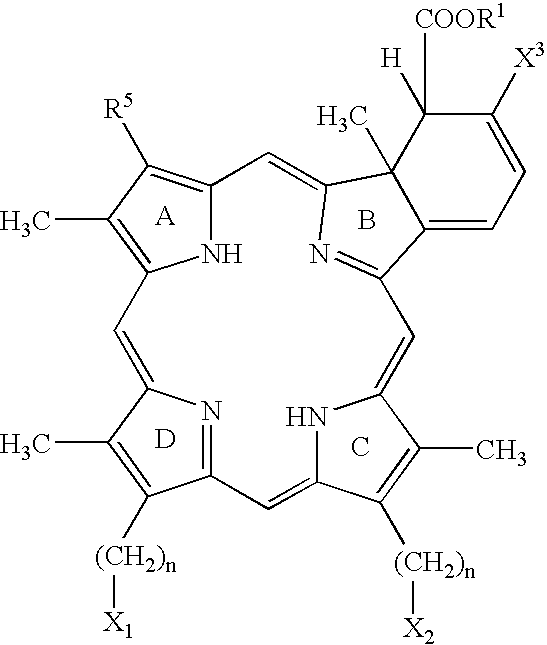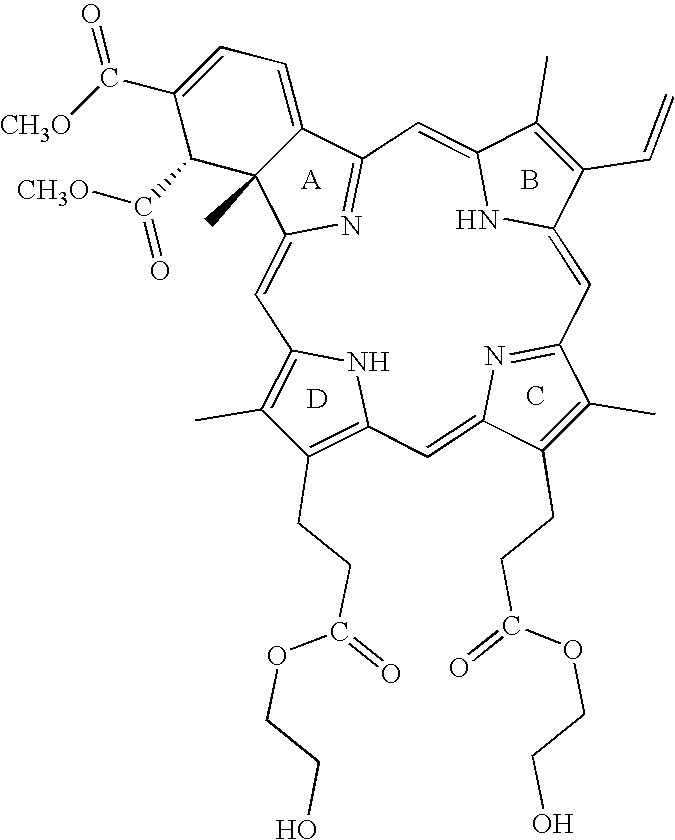Photodynamic Therapy For The Treatment Of Hyperactive Sebaceous Gland Disorders Using Topically Applied Hydrophobic Green Porphyrins
- Summary
- Abstract
- Description
- Claims
- Application Information
AI Technical Summary
Benefits of technology
Problems solved by technology
Method used
Image
Examples
example 1
[0084]The effect of different red light doses on the mouse sebaceous glands in response to PDT was evaluated. Lemuteporfin ointment was applied to shaved flank skin of male Balb / c mice and left on for 30 min. Excess material was removed from the skin surface and the site was exposed to a 688-nm red light dose of 25, 50, 100, 200 or 400 J / cm2 delivered at an intensity of 50 mW / cm2. Three days later, mice were euthanized and full-thickness skin excised from the PDT treatment site as well as the untreated contra-lateral side. Skin samples were processed, sectioned and stained for lipid using Oil Red O. Numbers of Oil Red O-positive pilosebaceous units (PSU) per 4× microscopic image were determined by two independent readers. At all light doses the number of Oil Red O-positive PSU was less for the PDT-treated sites than for untreated sites.
example 2
[0085]Patients with moderate to severe acne as defined by the presence of pustular and or cystic lesions, with or without scarring, are assessed for PDT treatment with lemuteporfin 0.2% ointment. Prior to treatment, the areas to be treated with PDT are cleansed and cleared of any hair, skin lotions or cosmetic products.
[0086]Topical photosensitizer ointment (comprising 0.2 wt % lemuteporfin, 50 wt % PEG-200, 24 wt % Transcutol®, 10 wt % PEG-3350 and 15.8 wt % oleyl alcohol) is applied directly on the acne affected skin at a quantity of approximately 45 mg / cm2. The ointment is left on for absorption for 20-45 minutes. Immediately prior to light treatment, excess ointment is removed by gentle wiping with a water-based skin cleanser. Acne lesions and the immediate surrounding areas are illuminated with 689 nm PDT light at a dose of 100 J / cm2 with an intensityof 50 mW / cm2.
PUM
| Property | Measurement | Unit |
|---|---|---|
| Temperature | aaaaa | aaaaa |
| Time | aaaaa | aaaaa |
| Fraction | aaaaa | aaaaa |
Abstract
Description
Claims
Application Information
 Login to View More
Login to View More - R&D
- Intellectual Property
- Life Sciences
- Materials
- Tech Scout
- Unparalleled Data Quality
- Higher Quality Content
- 60% Fewer Hallucinations
Browse by: Latest US Patents, China's latest patents, Technical Efficacy Thesaurus, Application Domain, Technology Topic, Popular Technical Reports.
© 2025 PatSnap. All rights reserved.Legal|Privacy policy|Modern Slavery Act Transparency Statement|Sitemap|About US| Contact US: help@patsnap.com


